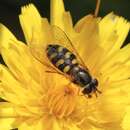Eupeodes luniger is a common species of hoverfly.[1][2][3][4]
It is characterized by hook-shaped markings along the center of its abdomen.[5]
Description
External images For terms see Morphology of Diptera
Wing length 7·5-8·5 mm. Male: postocular orbit less than 0.5 of its maximal width near vertex. Female: frons with white dust spots, the undusted area extending as a black Y- shape into the yellow part. Tergite 5 with yellow side margin.[6] [7] [8][9] The male genitalia are figured by Dusek and Laska (1973).[10] The larva is illustrated by Rotheray (1993)[11]
Distribution
Palaearctic from Fennoscandia South to Iberia and the Mediterranean basin. Ireland East through Europe into Asia Minor. European Russia, the Russian Far East and Siberia to the Pacific coast (Kuril Isles). Japan. North India. A highly migratory species .[12]
Biology
Habitat: Open ground, dune grassland, grassland and forest, woodland clearings and tracks, farmland and orchards, suburban gardens. Up to 2,000m in the Alps.[13] Flowers visited include white Umbelliferae, Calluna, Leontodon, Malus sylvestris, Polygonum cuspidatum, Prunus spinosa, Ranunculus, Rosa rugosa, Senecio, Taraxacum.[14] The flight period is April to November (earlier in South Europe). The larva feeds on aphids. Barkemeyer (1994) details the biology of E. luniger[15]
References
-
^ Ball, S.G.; Morris, R.K.A. (2000). Provisional atlas of British hoverflies (Diptera, Syrphidae). Monks Wood, UK: Biological Record Centre. pp. 167 pages. ISBN 1-870393-54-6.
-
^ Morris, Roger K. A. (1999). Hoverflies of Surrey. Surrey Wildlife Trust. p. 244. ISBN 0-9526065-3-4.
-
^ Stubbs, Alan E.; Falk, Steven J. (1983). British Hoverflies: An Illustrated Identification Guide. British Entomological & Natural History Society. p. 253, xvpp.
-
^ Van Veen, M.P. (2004). Hoverflies of Northwest Europe, Identification Keys to the Syrphidae (Hardback). Utrecht: KNNV Publishing. p. 254. ISBN 90-5011-199-8.
-
^ A. Dale. "A Nature Observer′s Scrapbook : Hoverflies". Retrieved 2010-06-17.
-
^ Van Veen, M. (2004) Hoverflies of Northwest Europe: identification keys to the Syrphidae. 256pp. KNNV Publishing, Utrecht.addendum
-
^ Van der Goot,V.S. (1981) De zweefvliegen van Noordwest - Europa en Europees Rusland, in het bijzonder van de Benelux. KNNV, Uitgave no.32: 275pp. Amsterdam.
-
^ Bei-Bienko, G.Y. & Steyskal, G.C. (1988) Keys to the Insects of the European Part of the USSR, Volume V: Diptera and Siphonaptera, Part I. Amerind Publishing Co., New Delhi. ISBN 81-205-0080-6.
-
^ Coe, R.L. (1953) Diptera: Syrphidae. Handbks.ident.Br.insects, 10(1): 1-98. R.ent.Soc.London. pdf Archived 2018-10-04 at the Wayback Machine
-
^ Dusek J. & Laska P. (1973) Descriptions of five new European species of the genus Metasyrphus (Diptera: Syrphidae), with notes on variation within the species. Acta ent.bohemoslov., 70(6): 415-426.
-
^ Rotheray G., 1993 Colour Guide to Hoverfly Larvae Diptera, Syrphidae in Britain and Europe Dipterists Forum pdf
-
^ Fauna Europaea
-
^ Speight, M.C.D. (2011). "Species accounts of European Syrphidae (Diptera)" (PDF). Syrph the Net, the Database of European Syrphidae. 65: 285pp.
-
^ Peck, L.V. (1988) Syrphidae. In: Soos, A. & Papp, L. (eds.) Catalogue of Palaearctic Diptera, 8: 11-230. Akad.Kiado, Budapest.
-
^ Barkemeyer, W. (1994) Untersuchung zum Vorkommen der Schwebfliegen in Niedersachsen und Bremen (Diptera: Syrphidae). Naturschutz und Landschaftspflege in Niedersachsen, 31: 1-514.



 Female in flight
Female in flight